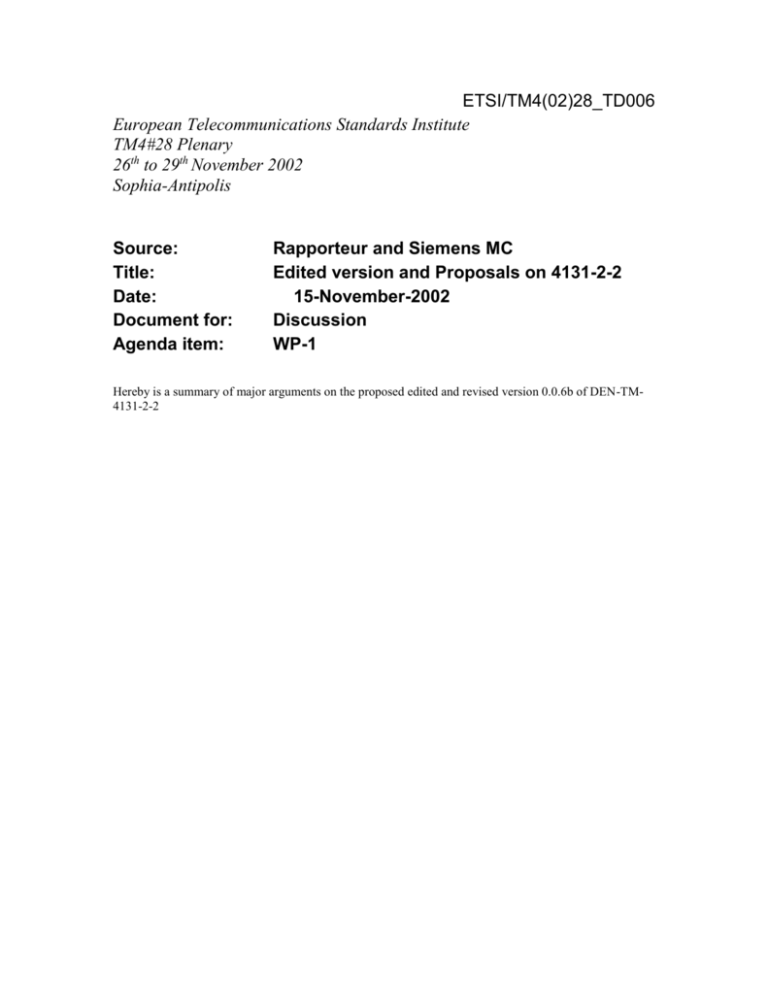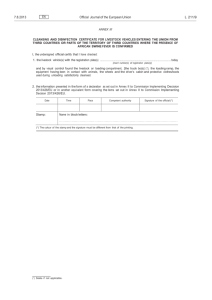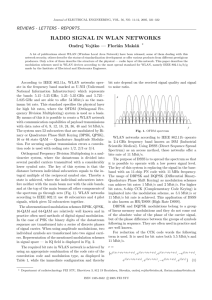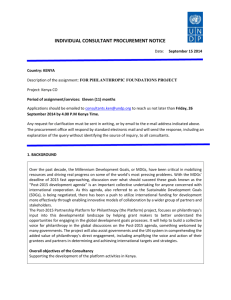28-TD006-Readme-2-2v06b
advertisement

ETSI/TM4(02)28_TD006 European Telecommunications Standards Institute TM4#28 Plenary 26th to 29th November 2002 Sophia-Antipolis Source: Title: Date: Document for: Agenda item: Rapporteur and Siemens MC Edited version and Proposals on 4131-2-2 15-November-2002 Discussion WP-1 Hereby is a summary of major arguments on the proposed edited and revised version 0.0.6b of DEN-TM4131-2-2 Editor Major Comments to edited version 0.0.6b of 4131-2-2 Part The attached files are the rev-mark and clean version of the file edited according discussions in last interim. In particular al (I hope) agreed modifications have been introduced and the Annexes structure have been unified (as much as possible) Tables have also been integrated in larger tables. Annex E (that was possibly never edited by STF) is now fully revised and aligned to the general structure. The main points of revision are hereby summarised: Antenna parameters (for integral equipment) had been duplicated by STF190, as TX requirement (clause 4.2.x) and RX requirements (clause 4.3.x), for the issue of receive only equipment (space diversity) that still have antenna requirement. The proposal is now to eliminate the redundancy and create a separate clause (4.4.x) concentrating antenna requirements for both TX and RX For sake of easy drafting the decided introduction of 2x34(68) Mbit/s in 28 MHz (class 4) and 2xSTM-0 (100) Mbit/s in 28 MHz (class 5B) have been derived (when not already available as 2x34 in lower 7 to 18 GHz bands) by doubling the equivalent 34 Mbit/s and STM-0 within 14 MHz that were present in all bands from 7 to 38 GHz (but also in bands 52 and 55 GHz was easy to be made and has been proposed; only 50 GHz band is excluded). Therefore the numbers for them, with respect to 34 and STM-0 requirements are: - RSL : 3 dB higher - Co-channel C/I = same - Adjacent C/I = same EN 300 431 still contained “class 2 Grade A” equipment, however, in the scope it is mentioned that: ”The deployment of Grade A equipment in new links will be limited and stopped over a period of time. Therefore, it is likely that provision for Grade A equipment will be removed from the present document during the next revision” According this trend already agreed in TM4 Grade A equipment have been removed Frequency tolerance inclusion in Spectrum mask is somehow unclear in some published EN. While for frequency below 23 GHz no tolerance is included (with the exception of 1.4 and 2.6 GHz that has been maintained) from 23 and above the situation is: EN 300 198 (23 GHz): There is no clear statement, spectrum masks for classes 3 and 4 reported a note: “Frequency expressed from nominal transmitter centre frequency [MHz]” while other masks reported similar note: “Frequency expressed from actual transmitter centre frequency [MHz]” Edited version: Assuming that the “nominal” is a cut-and-paste editorial error and also reading previous version V1.2 were the tolerance was clearly excluded, NO tolerance included. EN 300 431 (26/28 GHz): In this case it is clearly written “The masks for class 2 systems include an allowance for frequency tolerance (see note) while for class 3, 4 and 5 systems it does not include frequency tolerance” Edited version: Assuming that this is an old heritage of first versions of ETS 300 431, in any case the situation of “NOT included” is less stringent than the “included” requirement and for sake of uniformity the NO tolerance included for all systems is proposed. In conclusion a General rule for tolerance has been moved to a note in main body (clause 4.2.4.1): NOTE: The masks do not include frequency tolerance. Only systems reported in Annex A are exception to this general rule; in that case f0 identifies the nominal carrier frequency and the spectrum mask includes allowance for the frequency tolerance. BER 10-3 reminding : the agreed note has been introduced in section 4.3.2 Generic C/I requirement: Generic text was missing and has been introduced in section 4.3.3 Annex Structure: The structure has been unified, unfortunately the structure of complex tables (condensed for similarity) has evolved as far as the Annexes has been revised and presently some differences (not particularly important in editor opinion) are present, shown in particular by Tables in annex B (many systems in the same bands) and annex E (many systems in many bands). Further improvement might be possible. Section 4 (requirements): A note with generic reference to additional, not-essential, characteristics possibly found in Part 2-1. Channel arrangements: As introduction to the table of channel arrangement the following general remarks have been introduced: In the following Table ITU-R or CEPT/ECC recommended frequency channel arrangements, known at the date of publication of this EN, are reported for reference only. The channel arrangement is not relevant to article 3.2 requirements; only the frequency band and actual channel separation are relevant for defining the set of parameters and test suites relevant to each system designed for that channel separation. Other national or future ITU-R or CEPT/ECC recommendations, set around the rough boundary of present ITU-R or CEPT/ECC recommendations, are considered applicable to systems assessed against this EN, provided that they use the same channel separation. For assessment of wide-band coverage systems see Annex G. Scope: Base-band interfaces and capacity, more complex (provisionally including Spatial reuse) and simpler systems: Besides what reported in Annex F for packet and other “unconventional” capacities some general remarks for “conventional” capacities (already present in some ENs) and the applicability to special systems where generally extended to all Annexes with some generic sentences in the Scope: The capacities in Tables X.2 (where X=B…E represents the relevant Annex applicable) are commonly tailored on typical PDH and SDH baseband interface, identified for simplicity with 2 Mbit/s, 8 Mbit/s, 2x 8 Mbit/s, 34 Mbit/s, 2x34 Mbit/s, STM-0, 2xSTM-0, STM-1, 2xSTM-1. Only systems in Annex A, due to the smaller channel separation provided, are exceptionally labelled with typical capacity rate without specific reference to PDH/SDH rates. Provided that they met all requirements of this annex, equivalent PDH transport rates (such as N × 2 Mbit/s in place of equivalent higher PDH rates or 140/4x34 Mbit/s in place of STM-1) may be used where appropriate. Also N × 2 Mbit/s mapped into SDH VC12 or VC2 transport bit rates (sub-STM-0 defined by ITU-T Recommendation G.708 [Error! Reference source not found.]) may be used where appropriate (e.g. 4xVC12 or 1xVC2 in place of a 8 Mbit/s PDH rate). Other base band interfaces are possible (e.g. packet data interfaces); for equipment assessment when other base band interfaces are foreseen see Annex F. The requirements of this part 2-2 of the multipart EN apply separately to each transmitter/receiver or single transmitters or receivers eventually used for combining more complex or simpler (e.g. space diversity receivers or single transmitters and receivers used for unidirectional links) fixed radio systems. Systems labelled with N x STM-1 (N=1,2) capacity might actually be aggregated for carrying STM-4 in more than one radio frequency channel, provided that each equipment for each channel meet the channel requirements. When frequency reuse (e.g. dual polarisation reuse or spatial1 frequency reuse) is applied, the requirements apply independently to each transmitter/receiver; the potential different interference potential of frequency reuse will be dealt in the frequency planning related to the licensing process. System classes major changes: As proposed in WP-1 interim the system classes has been re-aligned among all systems in all bands. Besides some mere change of numbers from some previous ENs, the following major re-addressing has been done: - Class re-definition (in part 2-1): Class 0: special cases of simplest modulation formats without spectrum efficiency requirements (typically used for private uses in less attractive bands) ??????????? Class 1: equipment spectral efficiency based on typical 2-states modulation scheme (e.g. 2-FSK, 2-PSK or equivalent); 1 The spatial frequency reuse is an application where different signals, at the same frequency, are transmitted and received on the same route using different, suitably spaced, antennas; their mutual interference is then decreased using a signal processing algorithm similar to the XPIC used in the polarisation frequency reuse. Class 2: Class 3: Class 4: Class 5A: Class 5B: equipment spectral efficiency based on typical 4-states modulation scheme (e.g. 4-FSK, 4-QAM, or equivalent); equipment spectral efficiency based on typical 8-states modulation scheme (e.g. 8PSK , or equivalent; it is also noted that, in this class, for design commonality with other efficiency classes, 16 QAM format is more popular). equipment spectral efficiency based on typical 16 or 32-states modulation scheme (e.g. 16 or 32-QAM, or equivalent). equipment spectral efficiency based on typical 64 or 128-states modulation scheme (e.g. 64 or 128-QAM, or equivalent), for cross-polar adjacent channel (ACDP) operation. equipment spectral efficiency based on typical 64 or 128-states modulation scheme (e.g. 64 or 128-QAM, or equivalent), for co-polar adjacent channel (ACCP) and possible frequency reuse (CCDP) operation Class 6A: - - - equipment spectral efficiency based on typical 256 or 512-states modulation scheme (e.g. 256 or 512-QAM, or equivalent), for cross-polar adjacent channel (ACDP) operation. Class 6B: equipment spectral efficiency based on typical 256 or 512-states modulation scheme (e.g. 256 or 512-QAM, or equivalent), for co-polar adjacent channel (ACCP) and possible frequency reuse (CCDP) operation. The above classes are indicative only and do not imply any constraint to the actual modulation format, provided that all the requirements in this EN are met. Class 3 equipment: STM-0/14 cross-polar and 28 co -polar only (unless justified by more stringent adjacent C/I) STM-0/14 co-polar (and 2xSTM-0/28): their characteristics (RSL and C/I) were in some old ENs more close to class 4 (e.g. 32 QAM), in some other more 64 QAM (class 5) like. For sake of distinction from 34 Mbit/s they have been generally considered class 5B (previous EN were sometimes in the same class of 34Mbit/14 (class 4)). Having the full scenario it might be that they should be better re-displaced to class 4 (WP-1 to decide. Previous “Grades A and B”: for distinguish from the “conventional” 5A and 5B (and 6A & 6B) classes, previous EN Grades of equipment (with different meaning than co-polar/cross-polar application) whenever still necessary have been modified into “Types”. 2Mbit/s within 3.5 MHz: Unless justified by more stringent masks and adjacent channel C/I, they have been moved to class 1. EN 301 387 (50 GHz)-Class 1: This EN contains such equipments that (2 Mbit/7MHz and 8Mbit/28MHz) that are not even class 1 (which has twice efficiency). Possibility is either not to carry on those systems or to define a “Class 0” as “Systems based on the simplest modulation formats without spectral efficiency requirements, used in the very specific cases (e.g. tele-surveillance devices) of 50 GHz band. Annex F: As briefly discussed before closing interim meeting, a simplified Table F.1 for the selection of PDH/SDH system parameters based on minimum RIC is proposed. Also BER/FER section is amended for proposed clarifications and flexibility. Annex G: Section G.3 (2/4xSTM-1 / STM-4 systems of EN 302 068) is proposed for amendment. It was clear in the EN 302 068 contest, however in this broader contest it might be misunderstood. Section G.4 BER/FER background seems informative of the recommended table in Annex F; it is proposed to be moved to Part 2-1 among other informative material. Annex I (new Informative): The agreed background for ATPC/RTPC relationship with spectrum mask (see doc 27_01_05r1) has been edited and introduced







